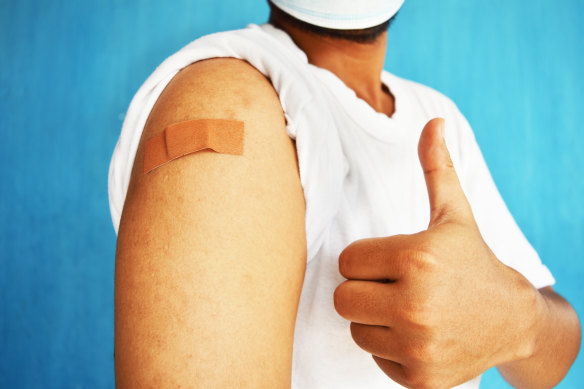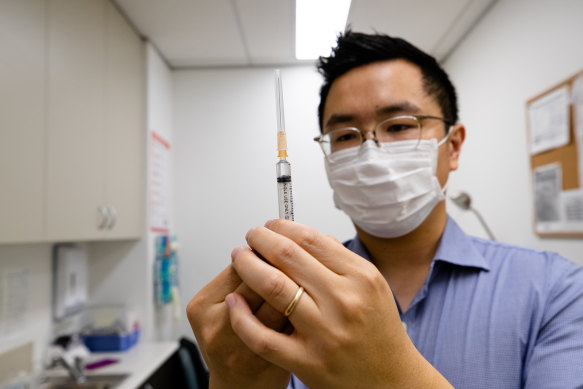This was published 2 years ago
Opinion
It’s a race to 80: The magic number that will let us live with COVID
By Brendan Coates and Tom Crowley
As Sydney’s lockdown is extended for at least another month, it’s easy to see the costs of COVID-19. While Australia has managed the pandemic better than most countries, we’re also tired and frustrated. We all know vaccines are the route to “living with” rather than “being overwhelmed by” COVID-19. But Australians are yet to see a plan to get us there.
Our new report, Race to 80: our best shot at living with COVID, shows that fully vaccinating 80 per cent of all Australians, and 95 per cent of over-70s, will give us the best chance of gradually returning to normal life – with open borders and no lockdowns. Aiming for anything less would risk a rapid surge in COVID-19 cases that overwhelms our hospitals, sending us back into long lockdowns.

At least 80 per cent of Australians must be vaccinated so we can learn to live with COVID.Credit: Getty
It’s an ambitious target, but achievable with the right plan. We can get to 80 per cent by the end of year if a vaccine is approved for children under 12. Otherwise, we should aim for March 2022, by vaccinating a higher share of adults.
So far getting Australians vaccinated has been seen as the Morrison government’s job. It has comprehensively failed at the first hurdle: securing enough vaccines. From October, supply should no longer be the issue: Australia will soon have enough doses to vaccinate 80 per cent of all Australians. The challenge will instead be getting those shots into arms as quickly as possible.
States can help. They have plenty of skin in the game: the longer the rollout takes, the longer the risk of further lockdowns. Whereas the faster that states can drive up their own vaccination rates, the easier their own fight against COVID-19 will be. Premier Gladys Berejiklian has already expressed frustration that NSW has not been allocated enough doses, especially as the current outbreak rages. And if NSW, or any state, can reach 80 per cent vaccine coverage on its own it can confidently relax almost all restrictions – regardless of the state of the national vaccine rollout.
The federal government should let them help. Under its current plan, the federal government will allocate between just a fifth and one quarter of vaccine doses from August to December to state-run facilities. The bulk of the rollout is to be left to GPs. This balance is wrong. GPs are an important part of the rollout – about half of Australians who had not been vaccinated in June said they would prefer to receive their vaccine from a GP. But many people don’t have a regular GP, and there are limits on how many doses GPs can administer. We should be much more ambitious.
The state clinics that already exist – like the one at Sydney Olympic Park – are much more efficient. They can deliver up to 1400 doses every eight hours, about two-to-five times more than GPs. They can offer walk-ins, and they are highly visible.
The states should expand state vaccination centres to make it as easy as possible for anyone who wants a jab to get one. Clinics should be established at convenient locations: at major sports events, workplaces, universities, public transport stations, housing commission estates, regional town centres, religious centres, and schools. They could run mobile and home-visit vaccination programs to target under-vaccinated areas or to reach groups who might find it hard to make time to get vaccinated, like single parents.
State governments should be also prepared to adopt the stronger incentives they have in their arsenal – requiring domestic “vaccine passports” for entry to major events, major public venues, and hospitality and entertainment settings, measures which are justified when the alternative is restrictions on the whole population. Nearly three quarters of Australians support this idea. Several countries have already implemented vaccine passports, and the federal government has developed digital certificates to allow it to happen here.

Lindfield GP Dr Chris Lee with a syringe of the AstraZeneca vaccine. GPs are being underutilised in the rollout.Credit: Edwina Pickles
Every dose makes it easier for us to “live with COVID-19” – by reducing the spread of the disease. Each vaccine shot also makes it less likely that severe restrictions would be needed to keep outbreaks in check while we race to 80. Vaccinating 50, or 60, or 70 per cent of a state’s population would make it much more plausible that future outbreaks could be crushed early with contact tracing alone.
For now, Australia’s vaccine rollout remains hampered by a lack of supply, and by challenges in promoting take-up of AstraZeneca. But we should be planning now to accelerate the rollout as soon as we can. That means putting state governments at the forefront of the vaccine rollout by giving them more vaccines and more leeway to get them in arms. The states have led the way in managing COVID. Now they need to lead again on the way out.
Brendan Coates is Economic Policy Program Director and Tom Crowley is an Associate at Grattan Institute.